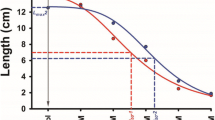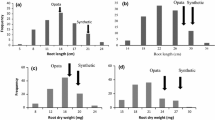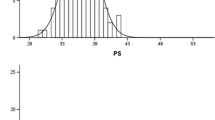Abstract
A deep and thick root system has a positive effect on wheat yield, particularly in drought environments. A doubled haploid (DH) population of 150 lines derived from the cross Hanxuan 10 × Lumai 14 was used to map QTLs for seedling root characteristics. The DH lines were cultivated in an agarose gel-chamber under well-watered (WW) and water-stressed (WS) regimes. Water stress was simulated by adding mannitol to the agarose gel. The seminal root traits, including maximum root length (MRL), seminal root number, total root length, project root area, root surface area, and seminal root angle were measured after 6 days of seedling development. Grain yields (GY) were measured in a field experiment. A total of 29 QTLs were identified for seedlings cultured under WW regimes, and 23 QTLs under WS regimes. Individual QTL accounted for phenotypic variations ranging from 4.98 to 24.31 %. The QTLs were distributed on 17 chromosomes, except 1D, 4D, 6B and 6D. Seven consistently expressed QTLs were detected for all the traits tested except MRL under both water regimes. The QTLs for root traits were unevenly distributed among chromosomes, and clustered in eight loci on seven chromosomes, showing pleiotropic effects on target traits. One region in the interval Xgwm644.2–P6901.2 on chromosome 3B contained 9 QTLs affecting most root traits. The present data provide an insight into the genetic basis of seedling root development under different water regimes and may benefit breeding programs using marker-assisted selection (MAS) for root traits.



Similar content being viewed by others
Abbreviations
- MRL:
-
Maximum root length
- SRN:
-
Seminal root number
- TRL:
-
Total root length
- PRA:
-
Project root area
- RSA:
-
Root surface area
- SRA:
-
Seminal root angle
- GY:
-
Grain yield
- WW:
-
Well-watered
- WS:
-
Water-stressed
References
An DG, Su JY, Liu QY, Zhu YG, Tong YP, Li JM, Jing RL, Li B, Li ZS (2006) Mapping QTLs for nitrogen uptake in relation to the early growth of wheat (Triticum aestivum L.). Plant Soil 284:73–84
Araki H, Iijima M (2001) Deep rooting in winter wheat: rooting nodes of deep roots in two cultivars with deep and shallow root systems. Plant Prod Sci 4:215–219
Araus JL, Bort J, Steduto P, Villegas D, Royo C (2003a) Breeding cereals for Mediterranean conditions: ecophysio-logical clues for biotechnology application. Ann Appl Biol 142:129–141
Araus JL, Villegas D, Aparicio N, García del Moral LF, El-Hani S, Rharrabti Y, Ferrio JP, Royo C (2003b) Environmental factors determining carbon isotope discrimination and yield in durum wheat under Mediterranean conditions. Crop Sci 43:170–180
Basten CJ, Weir BS, Zeng ZB (2001) QTLCARTOG-RAPHER Version1.15. Department of Statistics, North Carolina State University, Raleigh
Beebe S, Rojas-Pierce M, Yan X, Blair MW, Pedraza F, Munoz F, Tohme J, Lynch J (2006) Quantitative trait loci for root architecture traits correlated with phosphorus acquisition in common bean. Crop Sci 46:413–423
Bengough AG, Gordon DC, Al-Menaie H, Ellis RP, Allan D, Keith R, Thomas WTB, Forster BP (2004) Gel observation chamber for rapid screening of root traits in cereal seedlings. Plant Soil 262:63–70
Blum A (1989) Osmotic adjustment and growth of barley genotypes under drought. Crop Sci 29:230–233
Cui KH, Huang JL, Xing YZ, Yu SB, Xu CG, Peng SB (2008) Mapping QTLs for seedling characteristics under different water supply conditions in rice (Oryza sativa L.). Physiol Plantarum 132:53–68
Devaiah BN, Nagarajan VK, Raghothama KG (2007) Phosphate homeostasis and root development in arabidopsis is synchronized by the zinc finger transcription factor ZAT6. Plant Physiol 145:147–159
Ekanayake IJ, O’Toole JC, Garrity DP, Masajo TM (1985) Inheritance of root characters and their relations to drought resistance in rice. Crop Sci 25:927–933
Fracheboud Y, Ribaut JM, Vargas M, Messmer R, Stamp P (2002) Identification of quantitative trait loci for cold-tolerance of photosynthesis in maize (Zea mays L.). J Exp Bot 53:1967–1977
Fritsch R (1977) Über morphologische wurzelmerkmale bei Triticum L. und Aegilops L. (Gramimeae). Kult 25:45–70
Gloria SC, Ito O, Arcelia AA (2002) Physiological evaluation of responses of rice (Oryza sativa L.) to water deficit. Plant Sci 163:815–827
Hao ZF, Chang XP, Guo XJ, Jing RL, Li RZ, Jia JZ (2003) QTL mapping for drought tolerance at stages of germination and seedling in wheat (Triticum aestivum L.) using a DH population. Sci Agric Sin 2:943–949
Hervé D, Françoise F, Berrios EF, Leroux N, Chaarani GA, Planchon C, Sarrafi A, Gentzbittel L (2001) QTL analysis of photosynthesis and water status traits in sunflower (Helianthus annuus L.) under greenhouse conditions. J Exp Bot 52:1857–1864
Hetz W, Hochholdinger F, Schwall M, Feix G (1996) Isolation and characterisation of rtcs a mutant deficient in the formation of nodal roots. Plant J 10:845–857
Hund A, Fracheboud Y, Soldati A, Frascaroli E, Salvi S, Stamp P (2004) QTL controlling root and shoot traits of maize seedlings under cold stress. Theor Appl Genet 109:618–629
Ito K, Tanakamaru K, Morita S, Abe J, Inanaga S (2006) Lateral root development, including responses to soil drying, of maize (Zea mays L.) and wheat (Triticum aestivum L.) seminal roots. Physiol Plantarum 127:260–267
Jing RL, Chang XP, Jia JZ, Hu RH (1999) Establishing wheat doubled haploid population for genetic mapping by anther culture. Biotechnol 9:4–8
Kamoshita A, Wade LJ, Ali ML, Pathan MS, Zhang J, Sarkarung S, Nguyen HT (2002) Mapping QTLs for root morphology of a rice population adapted to rainfed lowland conditions. Theor Appl Genet 104:880–893
Kara Y, Martín A, Souyris I, Rekika D, Monneveux P (2000) Root characteristics in durum wheat (T. turgidum conv. durum) and some wild Triticeae species. Cereal Res Commun 283:247–254
Kathiresan A, Lafitte HR, Chen J, Mansueto L, Bruskiewich R, Bennett J (2006) Gene expression microarrays and their application in drought stress research. Field Crops Res 97:101–110
Kimurto PK, Kinyua MG, Birech R, Korir PC, Njoka EM, Njau PN (2005) Root and shoot characteristics as selection criteria for drought tolerance in bread wheat (Triticum aestivum L.) at seedling stage under tropical environment. Discov Innov 17:74–84
Lafitte HR, Price AH, Courtois B (2004) Yield response to water deficit in an upland rice mapping population: associations among traits and genetic markers. Theor Appl Genet 109:1237–1246
Landi P, Sanguineti MC, Darrah LL, Giuhani MM, Salvi S, Conti S, Tuberoas R (2002) Detection of QTLs for vertical root pulling resistance in maize and overlap with QTLs for root traits in hydroponics and for grain yield under different water regimes. Maydica 47:233–243
Landjeva S, Neumann K, Lohwasser U, Borner A (2008) Molecular mapping of genomic regions associated with wheat seedling growth under osmotic stress. Biol Plantarum 52:259–266
Lebreton C, Lazic-Jancic V, Steed A, Pekic S, Quarrie SA (1995) Identification of QTL for drought responses in maize and their use in testing causal relationships between traits. J Exp Bot 46:853–865
Li ZC, Mu P, Li CP, Zhang HL, Li ZK, Gao YM, Wang XK (2005) QTL mapping of root traits in a doubled haploid population from a cross between upland and lowland japonica rice in three environments. Theor Appl Genet 110:1244–1252
Liao H, Rubio G, Yan X, Cao A, Brown KM, Lynch JP (2001) Effect of phosphorus availability on basal root shallowness in common bean. Plant Soil 232:69–79
Liao MT, Palta JA, Fillery IRP (2006) Root characteristics of vigorous wheat improve early nitrogen uptake. Aust J Agr Res 57:1097–1107
Lincoln S, Daly M, Lander E (1992) Mapping genes controlling quantitative traits with MAPMAKER/QTL 1.1. Whitehead Institute Technical Report, Cambridge
Løes AK, Gahoonia TS (2004) Genetic variation in specific root length in scandinavian wheat and barley accessions. Euphytica 137:243–249
Ludlow MM, Muchow RC, Brady NC (1990a) A critical evaluation of traits for improving crop yields in water-limited environments. Adv Agron 43:107–153
Ludlow MM, Santamaria JM, Fukai S (1990b) Contribution of osmotic adjustment to grain-yield in Sorghum bicolor (L.) moench under water-limited conditions. 2. Water-stress after anthesis. Aust J Agric Res 41:67–78
Lynch JP, Brown KM (2001) Topsoil foraging–an architectural adaptation of plants to low phosphorus availability. Plant Soil 237:225–237
Mac Key J (1979) Wheat domestication as a shoot: root interrelation process. In: Ramanujam S (ed) Proc 5th Int Wheat Genet Symp, vol 2. Indian Society of Plant Breeding and Genetics, New Delhi, India, pp 875–890
Manschadi AM, Christopher J, deVoil P, Hammer GL (2006) The role of root architectural traits in adaptation of wheat to water-limited environments. Funct Plant Biol 33:823–837
Manschadi AM, Hammer GL, Christopher JT, deVoil P (2008) Genotypic variation in seedling root architectural traits and implications for drought adaptation in wheat (Triticum aestivum L.). Plant Soil 303:115–129
Manske GGB, Vlek PLG. (2002) Root architecture–wheat as a model plant. In: Waisel Y, Eshel A, Kafkafi U (eds) Plant roots: the hidden half. Marcel Dekker Inc., New York, pp 249–259
McIntosh RA, Hart GE, Devos KM, Rogers WJ (1999). Catalogue of gene symbols for wheat. http://grain.jouy.inra.fr/ggpages/wgc
McPhee K (2005) Variation for seedling root architecture in the core collection of pea germplasm. Crop Sci 45:1758–1763
Nielsen KL, Miller CR, Beck D, Lynch JP (1999) Fractal geometry of root systems: field observations of contrasting genotypes of common bean (Phaseolus vulgaris L.) grown under different phosphorus regimes. Plant Soil 206:181–190
O’Toole JC, Bland WL (1987) Genotypic variation in crop plant root systems. Adv Agron 41:91–145
Omori F, Mano Y (2007) QTL mapping of root angle in F2 populations from maize ‘B73’ × teosinte ‘Zea luxurians’. Plant Root 1:57–65
Oyanagi A, Nakamoto T, Morita S (1993) The gravitropic response of roots and the shaping of the root system in cereal plants. Environ Exp Bot 33:141–158
Price AH, Courtois B (1999) Mapping QTLs associated with drought resistance in rice: progress, problems and prospects. Plant Growth Regul 29:123–133
Price AH, Townend J, Jones MP, Audebert A, Courtois B (2002) Mapping QTLs associated with drought avoidance in upland rice grown in the Philippines and West Africa. Plant Mol Biol 48:683–695
Rabbani MA, Maruyama K, Abe H, Khan A, Katsura K, Ito Y, Yoshiwara K, Seki M, Shinozaki K, Yamaguchi-Shinozaki K (2003) Monitoring expression profiles of rice genes under cold, drought, and high-salinity stresses and abscisic acid application using cDNA microarray and RNA gel-blot analyses. Plant Physiol 133:1755–1767
Reynolds M, Dreccer F, Trethowan R (2007) Drought-adaptive traits derived from wheat wild relatives and landraces. J Exp Bot 58:177–186
Salekdeh GH, Siopongco J, Wade LJ, Ghareyazie B, Bennett J (2002) A proteomic approach to analyzing drought- and salt-responsiveness in rice. Field Crops Res 76:199–219
Shi RL, Li HW, Tong YP, Jing RL, Zhang FS, Zou CQ (2008) Identification of quantitative trait locus of zinc and phosphorus density in wheat (Triticum aestivum L.) grain. Plant Soil 306:95–104
Slafer GA, Araus JL, Royo C, Garcı′a del Moral LF (2005) Promising eco-physiological traits for genetic improvement of cereal yields in Mediterranean environments. Ann Appl Biol 146:61–70
Steele KA, Price AH, Shashidhar HE, Witcombe JR (2006) Marker-assisted selection to introgress rice QTLs controlling root traits into an Indian upland rice variety. Theor Appl Genet 112:208–221
Su JY, Zheng Q, Li HW, Li B, Jing RL, Tong YP, Li ZS (2009) Detection of QTLs for phosphorus use efficiency in relation to agronomic performance of wheat grown under phosphorus sufficient and limited conditions. Plant Sci 176:824–836
Tambussi EA, Bort J, Araus JL (2007) Water use efficiency in C3 cereals under Mediterranean conditions: a review of physiological aspects. Ann Appl Biol 150:307–321
Trethowan RM, Reynolds M, Sayre K, Ortiz-Monasterio I (2005) Adapting wheat cultivars to resource conserving farming practices and human nutritional needs. Ann Appl Biol 146:405–413
Tuberosa R, Sabguineti MC, Landi P, Giuliani MM, Salvi S, Conti S (2002) Identification of QTLs for root characteristics in maize grown in hydroponics and analysis of their overlap with QTLs for grain yield in the field at two water regimes. Plant Mol Breed 48:697–712
Wang MB, Zhang Q (2009) Issues in using the WinRHIZO system to determine physical characteristics of plant fine roots. Acta Ecologica Sinica 29(2):136–138
Wang ZL, Mao XG, Li A, Chang XP, Liu HM, Jing RL (2011) Functional marker mapping of protein phosphatase 2A structural subunit gene TaPP2Aa in common wheat. Sci Agric Sin 44:2411–2421
Wei B, Jing RL, Wang CS, Chen JB, Mao XG, Chang XP, Jia JZ (2009) Dreb1 genes in wheat (Triticum aestivum L.): development of functional markers and gene mapping based on SNPs. Mol Breed 23:13–22
Wu XS, Wang ZH, Chang XP, Jing RL (2010) Genetic dissection of the developmental behaviours of plant height in wheat (Triticum aestivum L.) under diverse water regimes. J Exp Bot 61:2923–2937
Wu XS, Chang XP, Jing RL (2011) Genetic analysis of carbon isotope discrimination and its relation to yield in a wheat doubled haploid population. J Int Plant Biol 53:719–730
Wu XS, Chang XP, Jing RL (2012) Genetic insight into yield-associated traits of wheat grown in multiple rain-fed environments. PLoS ONE 7(2):e31249
Yang DL, Jing RL, Chang XP, Li W (2007a) Identification of quantitative trait loci and environmental interactions for accumulation and remobilization of water–soluble carbohydrates in wheat (Triticum aestivum L.) stems. Genet 176:571–584
Yang DL, Jing RL, Chang XP, Li W (2007b) QTL Mapping for chlorophyll fluorescence and associated traits in wheat (Triticum aestivum L.). J Int Plant Biol 49:646–654
Zeng ZB (1994) Precision mapping of quantitative trait loci. Genet 136:1457–1468
Zhang HY, Mao XG, Wu XS, Wang CS, Jing RL (2011) An abiotic stress response gene TaSnRK2.7-B in wheat accessions: genetic diversity analysis and gene mapping based on SNPs. Gene 478:28–34
Zhou XG, Jing RL, Hao ZF, Chang XP, Zhang ZB (2005) Mapping QTL for seedling root traits in common wheat. Sci Agric Sin 38:1951–1957
Zhu J, Nickelson SM, Kaeppler SM, Lynch JP (2006) Detection of quantitative trait loci for seminal root traits in maize (Zea mays L.) seedlings grown under differential phosphorus levels. Theor Appl Genet 113:1–10
Acknowledgments
We thank Professor Robert A McIntosh (Plant Breeding Institute, University of Sydney, NSW, Australia) for revising the manuscript. This work was supported by the CGIAR Generation Challenge Programme (GCP, G7010.02.01), and the National Basic Research Program of China (2010CB125905).
Author information
Authors and Affiliations
Corresponding author
Rights and permissions
About this article
Cite this article
Liu, X., Li, R., Chang, X. et al. Mapping QTLs for seedling root traits in a doubled haploid wheat population under different water regimes. Euphytica 189, 51–66 (2013). https://doi.org/10.1007/s10681-012-0690-4
Received:
Accepted:
Published:
Issue Date:
DOI: https://doi.org/10.1007/s10681-012-0690-4




